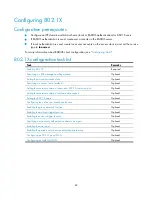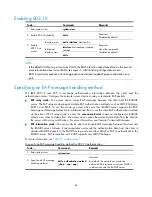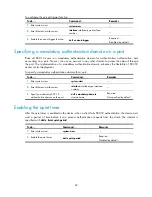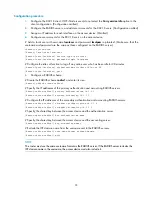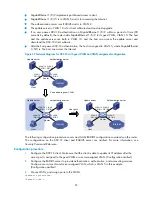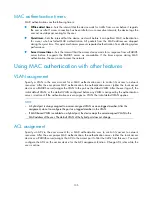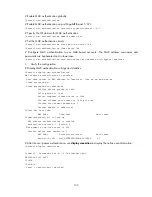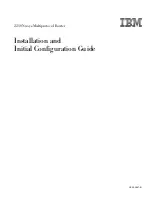
94
6.
Configure the ISP domain.
# Create the ISP domain
aabbcc.net
and enter its view.
[Router] domain aabbcc.net
# Apply the RADIUS scheme
radius1
to the ISP domain, and specify local authentication as the
secondary authentication method.
[Router-isp-aabbcc.net] authentication lan-access radius-scheme radius1 local
[Router-isp-aabbcc.net] authorization lan-access radius-scheme radius1 local
[Router-isp-aabbcc.net] accounting lan-access radius-scheme radius1 local
# Set the maximum number of concurrent users in the domain to 30.
[Router-isp-aabbcc.net] access-limit enable 30
# Configure the idle cut function to log off any online domain user who has been idle for 20 minutes.
[Router-isp-aabbcc.net] idle-cut enable 20
[Router-isp-aabbcc.net] quit
# Specify
aabbcc.net
as the default ISP domain. If a user does not provide any ISP domain name, it is
assigned to the default ISP domain.
[Router] domain default enable aabbcc.net
7.
Configure 802.1X.
# Enable 802.1X globally.
[Router] dot1x
# Enable 802.1X on port GigabitEthernet 1/0/1.
[Router] interface gigabitethernet 1/0/1
[Router-GigabitEthernet1/0/1] dot1x
[Router-GigabitEthernet1/0/1] quit
# Enable MAC-based access control on the port. (Optional. MAC-based access control is the default
setting.)
[Router] dot1x port-method macbased interface gigabitethernet 1/0/1
Verifying the configuration
Use
display dot1x interface gigabitethernet 1/0/1
to verify the 802.1X configuration. After an 802.1X
user passes RADIUS authentication, use
display connection
to view information about the user
connection. If the user fails RADIUS authentication, local authentication is performed.
NOTE:
For information about the RADIUS commands used on the access device in this example, see
Security
Command Reference.
802.1X with guest VLAN and VLAN assignment configuration
example
Network requirements
As shown in
:
•
A host is connected to port GigabitEthernet 1/0/2 of the Router and must pass 802.1X
authentication to access the Internet. GigabitEthernet 1/0/2 is in VLAN 1.



